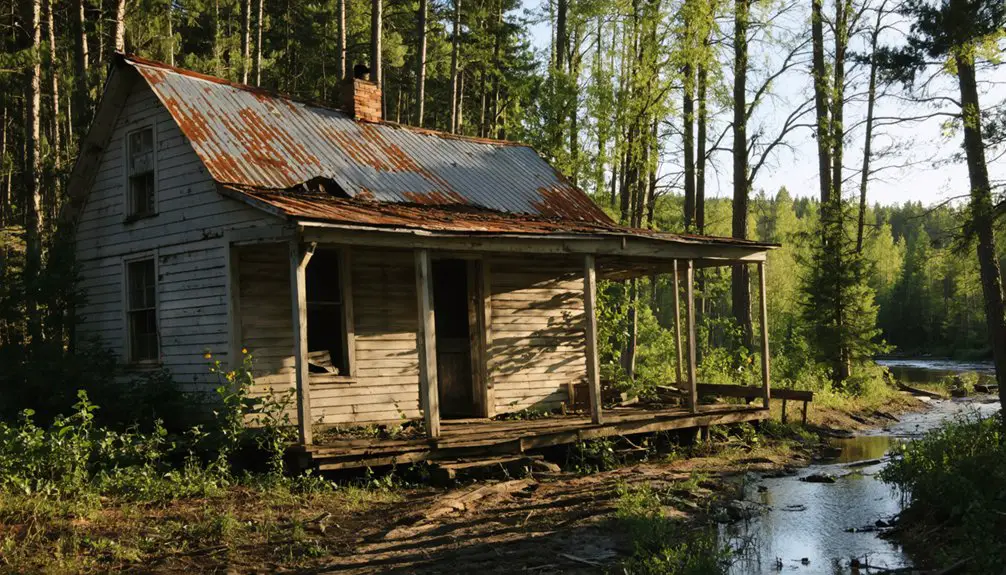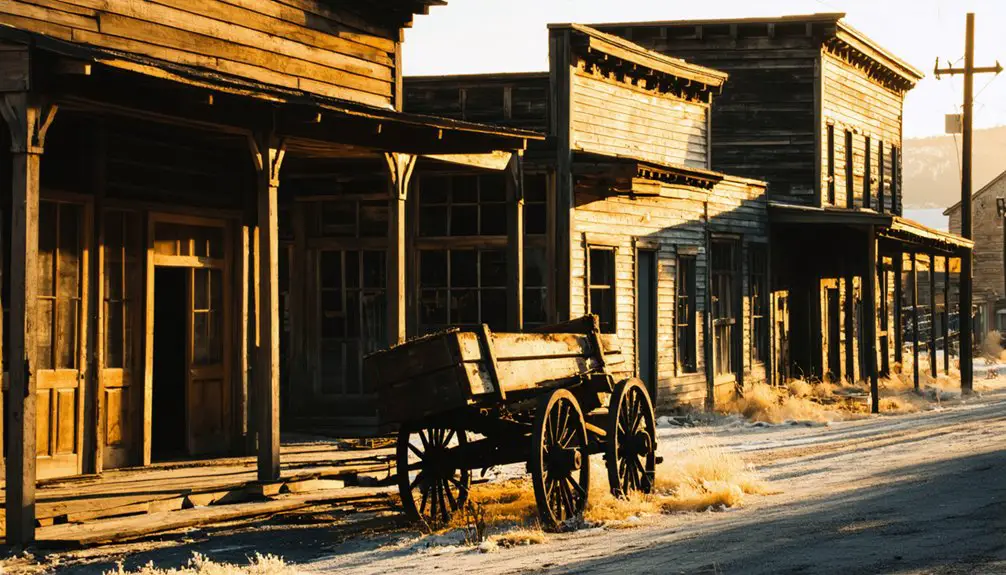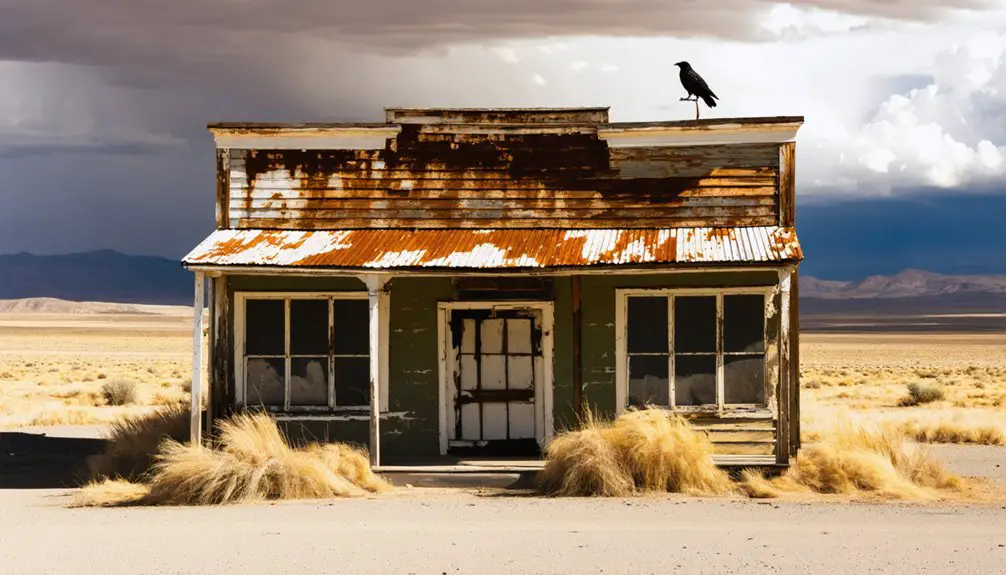You’ll discover Susanville’s remarkable story along Oregon’s Middle Fork John Day River, where gold fever sparked a thriving mining settlement in 1864. After miners brazenly stole an entire post office building from nearby Galena in 1901, the town flourished with over 1,000 weekend revelers and rich claims along Elk Creek. Though the 1913 Armstrong Nugget briefly rekindled hopes, by 1952 this once-vibrant community had transformed into the haunting ghost town you can explore today.
Key Takeaways
- Susanville emerged as a gold mining settlement in 1864 along Oregon’s Middle Fork John Day River, eventually becoming a ghost town.
- The town reached its peak around 1902 with 200 residents and successful mining operations valued at $600,000 before 1900.
- Famous for its dramatic post office theft from nearby Galena in 1901, which locals relocated to establish their own community.
- Saturday nights drew crowds exceeding 1,000 people for social gatherings, with bustling saloons and active trading of mining claims.
- Mining operations ceased by the 1910s, and the post office closure in 1952 marked Susanville’s final transition to ghost town status.
Origins of a Bustling Mining Camp
While the exact origins of Susanville’s original camp name remain unknown, this Oregon gold mining settlement emerged in 1864 along the Middle Fork of the John Day River, about 30 miles west of Sumpter.
You’ll find evidence of early mining techniques in the extensive placer operations that dominated production before 1900. The district’s rich deposits attracted determined prospectors who discovered notable veins including the Badger, Stockton, Bull of the Woods, Otter, and Gem – all producing valuable gold and silver ore. In 1913, local miner George Armstrong uncovered an impressive 80.4 ounce gold nugget that now resides in a Baker City bank. The town experienced significant growth and reached 200 residents by 1902.
The community’s resilience showed in 1901 when frustrated miners, tired of inadequate services, took matters into their own hands. They stole a post office from nearby Galena, establishing Susanville’s official name and securing their independence.
The Great Post Office Heist
The frustration over inadequate postal services reached a boiling point in 1901 when Susanville’s miners took bold, unprecedented action. Driven by years of fragmented postal services and the need to establish their own identity, the miners orchestrated a daring heist – physically stealing an entire post office building from nearby Galena. The community’s need for proper postal services eventually led to Frank Henry Bangham becoming the town’s Postmaster that same year.
You’ll find that the heist motivations went beyond mere postal convenience. The miners not only claimed the building and its contents but also appropriated the official name “Susanville” for their camp. The town’s residents understood that having reliable mail delivery was essential for maintaining connections with distant family and receiving important documents.
The stolen structure became their legitimate post office, marking a turning point in the town’s postal history. Later, hydraulic mining operations completely erased traces of the original post office site, leaving only the tale of this audacious act as evidence of the miners’ determination to secure their community’s future.
Gold Rush Glory Days
During Susanville’s heyday, you’d find prospectors working rich claims along Elk Creek and Buck Gulch, where George Armstrong’s famous 80.4-ounce nugget discovery in 1913 exemplified the area’s remarkable gold deposits.
The district’s mining success drew crowds that could swell to over a thousand on Saturday nights, with miners spending their earnings in the bustling town of 200 permanent residents.
Similar to the Honey Lake Valley settlement patterns of 1856, individual prospectors and larger mining operations flourished side by side in the growing community.
You’d witness both placer and lode mining operations throughout the district, with the Gem and Badger mines leading production while individual prospectors continued finding high-purity gold nuggets worth hundreds of dollars each in the creek beds.
Rich Mining Claims
Mining fever struck Susanville in 1864 when prospectors discovered rich placer gold deposits along Elk Creek, igniting a rush of claim staking and mineral extraction that would define the district’s glory days.
You’d find fortune hunters working massive placer deposits that yielded legendary nuggets, including the stunning 80.4-ounce Armstrong Nugget discovered in 1913.
While placer mining dominated early profits, quartz mining emerged by 1869 with claims like the Gem mine showcasing ore values of $16 per ton.
The Badger mine became the district’s flagship operation by 1902, though difficult access limited profitability to only the richest veins.
Chinese miners worked hydraulic operations along Elk Creek, contributing to the district’s impressive $600,000 production value before 1900.
Even after peak production, dredging operations continued extracting wealth through 1959.
The area’s rich mining heritage made it one of Oregon’s most significant gold rush towns until its eventual decline.
Thousand-Strong Saturday Nights
While hard work dominated weekdays in Susanville’s mining district, Saturday nights transformed the quiet camp into a bustling social hub where nearly a thousand people would gather to celebrate their weekly fortunes.
You’d witness miners, merchants, and families converging for community celebrations that brought economic rejuvenation to local businesses. These vibrant gatherings featured music from fiddles and guitars, while shared meals and dancing created lasting bonds among the diverse population.
- Saloons and general stores buzzed with activity as the week’s earnings circulated through town.
- Impromptu stages hosted performances while creek beds served as natural dance floors.
- Claims were bought and sold during social hours, mixing business with pleasure.
The weekend revelry exemplified the freedom and opportunity that drew people to Oregon’s mining camps, fostering a resilient community spirit despite harsh conditions.
Armstrong Nugget Discovery
A remarkable discovery shook the mining community of Susanville on June 19, 1913, when George Armstrong unearthed an 80.4-troy-ounce gold nugget from his placer claim along the Middle Fork John Day River.
You can imagine the excitement as Armstrong and his partners, who’d filed the claim in 1906, used high-pressure water to sluice through the rock before spotting the massive yellow chunk of gold.
The nugget’s significance became immediately apparent – it was the largest ever found in the Susanville area. This discovery became a cornerstone of Oregon’s geological heritage.
Under armed guard, they transported it to Baker City’s bank, where you can still view it today at U.S. Bank. The miners initially secured a loan of $200 against the valuable find.
Armstrong’s discovery represents the pinnacle of Oregon’s mining heritage, a tribute to the region’s rich gold deposits and the determined prospectors who sought their fortunes through placer mining techniques.
Life Along Elk Creek

You’d find miners working their claims along Elk Creek’s narrow canyon, using hydraulic giants to blast the earth and running the ore through stamp mills in search of gold.
On Saturday nights, you could join nearly 1,000 miners who’d flood into town, transforming the single main street into a bustling social hub centered around the combination store and post office.
The discovery of the massive 80.4-ounce Armstrong nugget in 1913 would’ve caused quite a stir among the locals, proving that significant gold strikes were still possible even after the early rush years.
Mining Along The Creek
Since its discovery in 1864, Elk Creek became the lifeblood of Susanville’s mining operations, with placer gold deposits driving the district’s production for nearly four decades.
You’d find miners working the creek’s rich placer deposits using various mining techniques, with some striking it big through impressive nugget discoveries.
- George Armstrong unearthed an 80.4-ounce nugget valued at $1,415 in 1913
- Miners discovered gold nuggets worth $480 to $800 each
- A ten-stamp mill processed ore worth $16 per ton in gold and silver
The creek’s potential attracted serious investment, as shown by John Harrington’s $140,000 purchase of 14 claims in 1901.
Underground operations like the Gem Mine used pumps to manage water while working quartz veins, which were typically two feet wide and required concentrated effort to extract their valuable ore.
Saturday Night Social Scene
Life along Elk Creek transformed dramatically every Saturday night as up to 1,000 miners descended upon Susanville’s single main street, turning the quiet mining town into a bustling social hub.
You’d find miners gathering at the local store and post office, sharing tales of their week’s discoveries and hardships. These social gatherings weren’t just about entertainment – they were essential for building community bonds in this isolated canyon settlement.
The town’s geography, constrained by Elk Creek’s narrow walls, actually enhanced these weekly festivities by concentrating everyone along one main thoroughfare.
After grueling days of placer mining, you’d witness the transformation as workers shed their solitary roles, joining together in celebration. The discovery of massive gold nuggets, like the Armstrong find, only amplified the excitement of these Saturday night occasions.
The Armstrong Nugget Legacy
The Armstrong Nugget stands as one of Oregon’s most remarkable gold discoveries, unearthed on June 19, 1913, by prospector George Armstrong at his placer mine near Susanville. This 80.4-ounce golden treasure represents the region’s mining heritage and continues to captivate visitors at its current home in Baker City’s U.S. Bank branch.
- You’ll find this nugget’s significance deeply rooted in the Armstrong family’s determination, having filed an 80-acre placer claim in 1906.
- The discovery helped establish Susanville’s reputation as a prosperous mining district, which later produced over 17,800 ounces through dredging.
- You can trace the region’s pioneering spirit through this golden monument to perseverance.
Following the peak prosperity of the early 1900s, the town gradually declined until its post office closed in 1952. The high security measures will protect this historic treasure when it moves to its new home at Baker Heritage Museum. The Armstrong Nugget remains a powerful symbol of individual prospecting success and the enduring legacy of Oregon’s gold rush era.
Daily Life in a Mountain Mining Town

During Susanville’s peak mining years, you’d find residents adapting to harsh mountain conditions while building a determined community at nearly 9,000 feet elevation.
Your daily routines would revolve around the mines, where you’d operate water-powered drills and handle dynamite in dangerous conditions. After exhausting shifts, you’d gather at the saloons or dance halls, sharing whiskey with fellow miners and swapping stories.
You’d live in simple wooden shacks, sharing cramped quarters with other workers. Kerosene lamps would light your way until the 10 PM curfew.
Community gatherings centered on mutual survival, especially during the eight-month winters when you’d help neighbors shovel snow and maintain essential supply trails. You’d rely on packhorses and snowshoes to stay connected, facing isolation together in this rugged mountain settlement.
A Ghost Town’s Final Chapter
As mining fortunes dwindled in the early 1900s, Susanville’s story took an unexpected turn when miners relocated the post office two miles up Elk Creek to establish “New Susanville,” leaving the original settlement to become Galena.
The discovery of the 80.4-ounce Armstrong Nugget in 1913 brought a brief flash of excitement, but couldn’t halt the town’s decline toward its final chapter.
- By the 1910s, mining operations had largely ceased, though a few determined residents held on.
- The narrow canyon’s constraints prevented expansion beyond a single main street.
- The post office’s closure in 1952 marked Susanville’s official transformation into a ghost town.
Today, you’ll find locked cabins and abandoned structures tucked into the canyon, while the Armstrong Nugget rests in Baker City as a symbol of Susanville’s golden age.
Frequently Asked Questions
How Many People Still Live in Susanville Today?
You won’t find current population statistics, as it’s fundamentally uninhabited today. Though it holds historical significance as a former settlement, official records indicate it’s now considered a ghost town in Grant County.
What Is the Best Way to Access the Ghost Town Site?
You’ll need to drive through Galena and follow the only road leading out, but respect “No Trespassing” signs. There aren’t official hiking routes, so local knowledge and high-clearance vehicles are essential.
Are There Any Remaining Buildings Visitors Can Safely Explore?
You can’t safely explore any remaining buildings due to severe structural deterioration and clear “No Trespassing” signs. For historical preservation and exploration safety, you should only view structures from a distance.
What Happened to the Families Who Lived There After Mining Ended?
While you might think they stayed together, most families scattered as mining ended. You’ll find their legacy spread across nearby towns like Galena and Bates, where they sought new opportunities and livelihoods.
Was Susanville Ever Connected to Other Towns by Railroad?
You’ll find that after several failed proposals, the Fernley & Lassen Railroad finally connected Susanville in 1913, opening essential town connections for lumber shipping and passenger service through the region’s railroad history.
References
- https://pnwphotoblog.com/ghost-town-of-susanville-oregon/
- https://kids.kiddle.co/Susanville
- https://easyrider.easyrider.com/susanville_2016.htm
- https://westernmininghistory.com/towns/oregon/susanville/
- https://www.lcoe.org/Services/Events/Curriculum-Resources/Historic-Towns-of-Lassen-County/
- https://www.oregon.gov/dogami/milo/archive/Pubs/Lindgren/Lindgren1901GoldBeltBlueMtns_Chp5_p705-720_OCR150dpi.pdf
- https://archaeologyroadshow.org/mining-on-the-malheur-national-forest/
- https://tipurdy.org/susanville-oregon/
- https://www.youtube.com/watch?v=wBJ08tBvIuM
- https://susanvillestuff.com/from-the-files-of-the-lassen-historical-society-susanville-post-office-safe/



